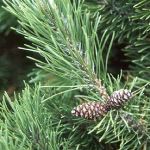| Common Name: |
Mugo Pine |
| Other Names: |
Dwarf Mountain Pine |
| Botanical Name: |
Pinus mugo |
| Genus: |
Pinus |
| Family: |
Pinaceae |
| Native Location: |
C European Alps |
| Cultivation: |
Well-drained, neutral to acid soil in sun. Pinus sylvestris thrives in both acid and alkaline soils. Pinus palustris tolerates drought and poor soil but needs warmth and humidity. Remove dead branches in winter. Restrict the leading shoots. Foliage may be damaged by adelgids, caterpillars of the pine-shoot moth, sawfly larvae, canker, dieback, Botrytis, and rust. Trees may be killed by honey fungus. |
| Propagation: |
By seed sown in spring (species and varieties only); by layering (P. mugo Pumilio Group); by grafting in late winter (cultivars). |
| Harvest: |
Leaves and young shoots are collected during the growing season and usually used fresh for decoctions and syrups (P. sylvestris). Resin is tapped by cutting vertical grooves in the bark and collecting the exudate; oil is distilled or solvent extracted from wood and bark (P. palustris). Oil is distilled from leaves (P. mugo Pumilio Group). Oils are processed into ointments, gels, emulsions, inhalants, and rubbing oils. Tar is distilled from roots (P. sylvestris). |
| Height: |
3.5m (11ft) |
| Width: |
5m (15ft) |
| Variations: |
Mops
Is slow growing, dense, and rounded.
Height:1.5m (5ft) |
Pumilio Group
syn. Var. Pumilio
Is shrubby, with erect branches. |
|
| Hardiness: |
Z2-8 |
| Parts Used: |
Oil (pumilio pine oil) |
| Properties: |
An aromatic, stimulant, antiseptic herb that is expectorant; relieves bronchial and nasal congestion; improves blood flow locally. |
| Medicinal Uses: |
Internally and externally for upper respiratory tract infections, whooping cough, chronic bronchitis, mucus, and asthma. Externally for rheumatism and muscular stiffness; aslo as decongestant inhalation. |
| Economic Uses: |
Oil is used in commercial food flavoring, and in woody perfumes. |
| Warning: |
May cause allergic reactions in susceptible individuals.
This herb, in the form of pumilio pine oil, is subject to legal restrictions in some countries. |
| Bibliography: |
Encyclopedia of Herbs by Deni Brown Copyright © 1995, 2001 Dorling Kindersley Limited. pp 318-319 |
